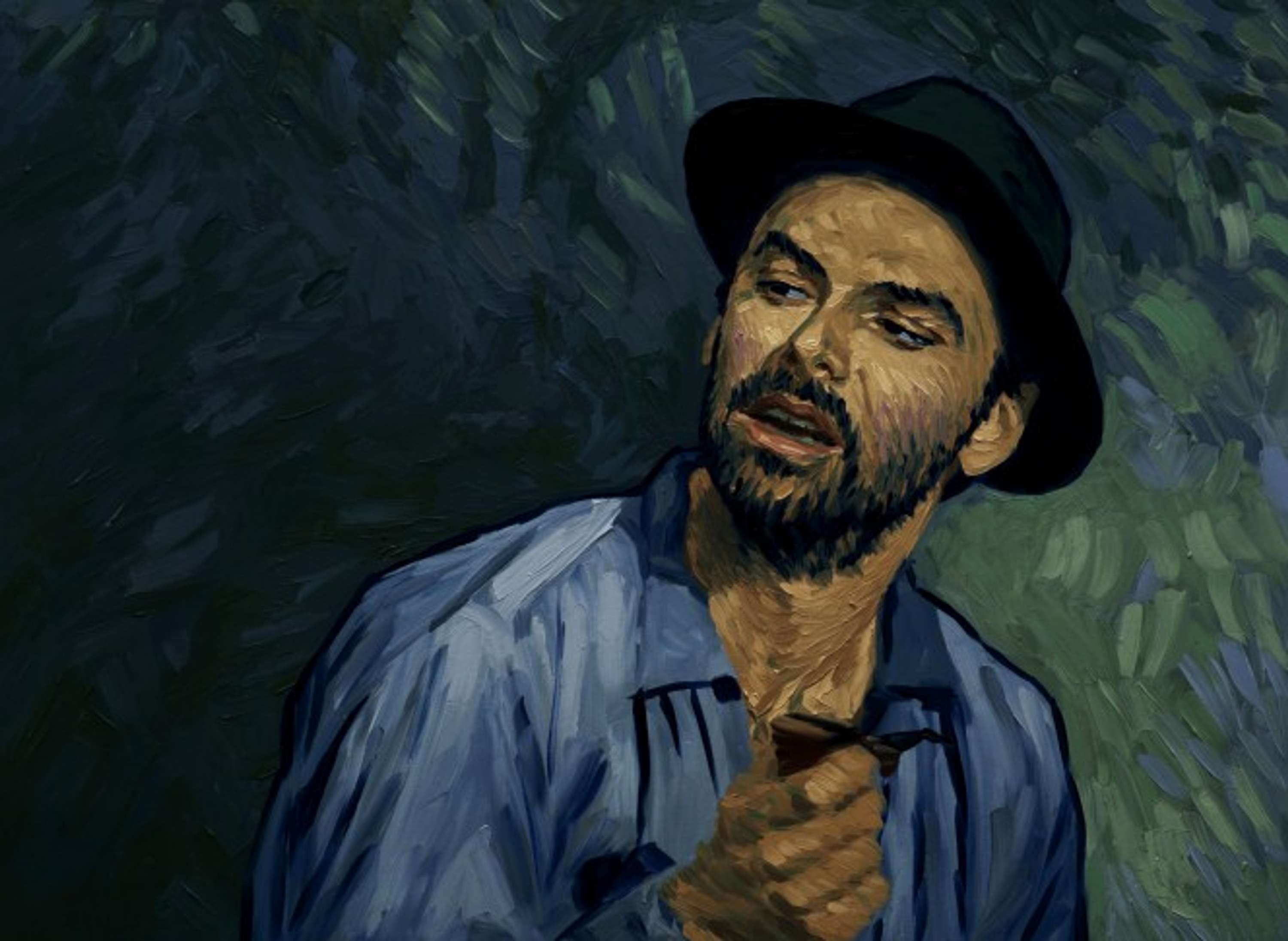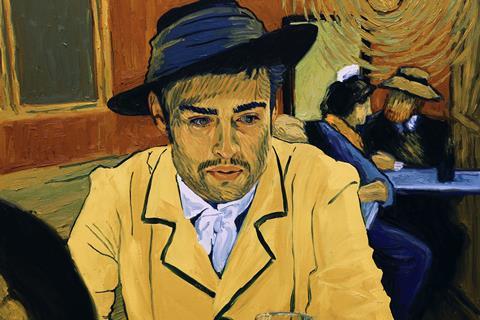Applying Narrative Theory To 'Loving Vincent'
Directed by Dorota Kobiela and Hugh Welchman, Loving Vincent (2017) is a feature-length painted animation, the first film of its kind, and explores the life and mysterious death of artist Vincent Van Gogh. The story is told through depictions of some of his most famous artworks and was created through over sixty-five-thousand paintings done by more than one-hundred artists around the world.
NARRATIVE
Vladirmir Propp's narrative theory on event functions from Russian fairy-tales suggests that there is a strict order to the events in a narrative and many of his proposed thirty-one event functions will feature. In Loving Vincent some do appear, including 'absentation' as protagonist Armand (above right) leaves his family home to go to Paris, in a quest to deliver the final letter Vincent wrote to his brother Theo before his supposed suicide, and 'first function of the donor' as Armand is tested by a number of people in the town as he awaits to receive more information on Vincent's death from the mysterious Dr. Paul Gachet. However many of Propp's character functions are not even remotely present in Loving Vincent, including the 'wedding', 'punishment' and 'struggle' - perhaps conveying that Loving Vincent is not a particularly mythical or traditional narrative, but does partially follow a conventional narrative structure as it does feature some of Propp's more general functions.
Tzvetan Todorov identified that most narratives are not only linear, but follow a five stage process. Loving Vincent certainly follows this typical 'Hollywood' structure. The film begins in Equilibrium until Vincent dies (Disruption), when Armand is send upon a Quest to deliver the letter to Theo. The ultimate Conflict comes when Armand accuses the young boy Rene or murdering Vincent, and a New Equilibrium is found when Armand returns home and receives a letter back from Theo's widow.
A Todorovian narrative recognisably rises and falls, whilst having a satisfying and simple effect of spectators as they understand that everything that has been disrupted in the film will return to peace and some form of normality after a climatic conflict. Perhaps a little predictable, Todorovian narratives give closure to audiences, there is an ease of understanding to them despite the possibility of them becoming repetitive and boring. Moreover, the fact Loving Vincent mirrors this simple framework suggests it is traditional and satisfying for audiences.
The 'three act structure' is additionally typical of most classic 'Hollywood' films, consisting of three acts, three major turning points, a typically longer Act 2, and each Act starting with an inciting incident. This structure is present in Loving Vincent the first act consisting of Armand travelling to Paris and ending with him being told of Theo's death, leading him to go to the South of France and begin Act 2 (the longest Act) where Armand attempts to understand why Vincent took his own life and where he can deliver the letter to. The final Act gives closure to audiences as Dr. Gachet finally returns to answer Armand's questions and the mystery of Vincent's death can be resolved. As Loving Vincent follows this typical structure, arguably the narrative of the film is especially conventional, following this simple structure to satisfy audiences and build a comprehensive story audiences find easy to understand. Essentially, it positions the audience in comfort, they understand how the film will progress and believe there will come some kind of resolution and closure, moreover perhaps the audience enjoy the film more in the conventional sense, as they understand the direction of the narrative further.
Joseph Campbell's 'The Hero's Journey' is another theory concerning narrative that in many ways is quite Proppian as it also works with mythic narratives. Campbell's theory however is also cyclical, with the hero of the story starting and returning to the place where they were once called to adventure, the only difference is that they are hoped to have grown, restored peace and a potential message of morality conveyed to audiences in the process. Armand in Loving Vincent (above) certainly follows this pattern, starting and ending at home speaking with his father, yet at the start of the narrative Armand is a drunk, foolish child with little drive and few aspirations, however at the end he has matured, understands things a little more and values life in a different way. He is also aided by helpers and mentors throughout the film as Campbell predicts and faces challenges and temptations. However there is not a wild transformation or sense of atonement in the film so perhaps although fitting some of the more conventional aspects of the theory, perhaps does not fit some of the more mythic ideas associated with the mythic narratives Campbell studied before creating the theory. Furthermore spectators note that the narrative is rather conventional and not particularly mythic or traditional in this sense, 'fitting' with some of the more generalised parts of The Hero's Journey such as the unspecific 'call to adventure' and general 'challenges and temptations'.
Propp also created a list of seven (potentially eight) character functions that can be identified in most tales. Comparing these functions to Loving Vincent, I find them to not be so cut and clear. Due to the constant flashbacks throughout the film there almost seems to be two narratives occurring. One with Armand as he attempts to deliver the letter and discover what really happened to Vincent, and the second flashbacks to Vincent himself (often as other characters in Armand's narrative address memories). Moreover despite Armand being the character that spectators follow in his quest, Vincent is arguably a second protagonist - there are two narratives for most of the characters: the narrative of the past and what happened whilst Vincent was alive, and the narrative in the present and what is happening as Armand continues his quest. Many of the characters display two different roles for each narrative, for example in the present Theo (Vincent's brother) is the princess as he is what the hero Armand is looking for to deliver the letter, he is 'the prize', whereas in the past Theo is the helper aiding the hero Vincent in his quest to create art. Moreover, due to the slightly more complex nature of the narrative in terms of character, Propp's character functions are not completely plausible and certainly not a perfect alignment. Furthermore, perhaps Loving Vincent is not a conventional or mythic narrative in terms of character as due to the two parallel story lines the roles of characters differs between the two, allowing audiences to essentially see two sides to every character - what they used to be like and how they have changed since Vincent's tragic death. Armand is perhaps simple trying to figure out the all-important why.
THEMES
Claude Levi-Stauss created a theory of Binary Oppositions, a theory that does not particularly 'fit' well with Loving Vincent. Armand's main opposition in the film is time - time was taken from Vincent which was the inciting incident which causes the whole narrative to begin, time was taken from Theo and so Armand must travel to find someone to deliver the letter to and time is given to Armand to ponder the reason behind Vincent's death as Dr. Gachet is not available to talk. Yet Armand and time are perhaps binary opposites as Armand is young, often wasting time before sent on his quest drinking and fighting. Perhaps it is experience vs. innocent through Vincent and Armand, Vincent has experienced so much emotionally and literally, whilst Armand has almost refused to enter the 'real world' and so remain perhaps more innocent. Perhaps the narrative is about the past vs. present and Armand attempts to discover what the relation between the two is. Due to the lack of binary opposites in the film, spectators do not perhaps understand who to be 'rooting' for. Like Armand, they simply want to understand the reason behind and events of Vincent's death, to create more interest in the narrative there are obstacles, but not 'binary opposites' as such. Therefore constructing the narrative as more interesting to audiences, less conventional and surprisingly, a tale which is less about morality. For narratives which are heavily dominated by morality often have these binary opposites of 'good and evil', conveying to audiences which is the 'preferred', yet Loving Vincent does not offer this to audiences and perhaps engages them for longer as they attempt to figure out what they are.
Overall, it can be argued that Loving Vincent is a conventional narrative, using a traditional 'Hollywood' structure of three acts and Todorov's narrative theory, resulting in a satisfying and perhaps slightly predictable narrative audiences can 'settle in to', knowing there will be closure.
Loving Vincent is additionally clearly not an especially mythical narrative as many of Propp's theories are not present in the film, suggesting that although the narrative follows a typical structure through it's 'three act' and featuring of some of Propp's more generalised functions, it is not mythic and only partially traditional because the dual-narrative in the film presents characters and events in two different lights, meaning that strict theories such as
The dual-narrative could easily be confusing and unsatisfying for audiences, but the directors choice to build a 'three act' structure means that the 'umbrella' narrative over both story-lines can come together and still remain satisfying with a sense of closure for spectators. Whilst the directors choice to include a lack of 'binary opposites' allows spectators to choose for themselves who to be 'rooting for', an interesting and certainly unconventional concept.
I believe the narrative to although be typical and rather simple, it is satisfying for audiences. I also believe that some of narrative theories have proved to be more useful as revealing things about the narrative, for example 'The Hero's Journey' is easily applicable and is a simple, yet effective theory that can often be clearly seen in film narratives and reveal the mythic/traditional aspects of it. Whilst the theory of 'binary opposites' is less useful, in a film like this they are rarely present and do not reveal a lot about the narrative itself.
Loving Vincent is additionally clearly not an especially mythical narrative as many of Propp's theories are not present in the film, suggesting that although the narrative follows a typical structure through it's 'three act' and featuring of some of Propp's more generalised functions, it is not mythic and only partially traditional because the dual-narrative in the film presents characters and events in two different lights, meaning that strict theories such as
The dual-narrative could easily be confusing and unsatisfying for audiences, but the directors choice to build a 'three act' structure means that the 'umbrella' narrative over both story-lines can come together and still remain satisfying with a sense of closure for spectators. Whilst the directors choice to include a lack of 'binary opposites' allows spectators to choose for themselves who to be 'rooting for', an interesting and certainly unconventional concept.
I believe the narrative to although be typical and rather simple, it is satisfying for audiences. I also believe that some of narrative theories have proved to be more useful as revealing things about the narrative, for example 'The Hero's Journey' is easily applicable and is a simple, yet effective theory that can often be clearly seen in film narratives and reveal the mythic/traditional aspects of it. Whilst the theory of 'binary opposites' is less useful, in a film like this they are rarely present and do not reveal a lot about the narrative itself.







You apply a wide range of narrative theories effectively to produce insights and reach convincing conclusions. You are constantly evaluating the usefulness (or otherwise) of the theories in respect of 'Loving Vincent'. Exactly what I was hoping for: well done. You are now an expert in narrative analysis! Grade A
ReplyDelete